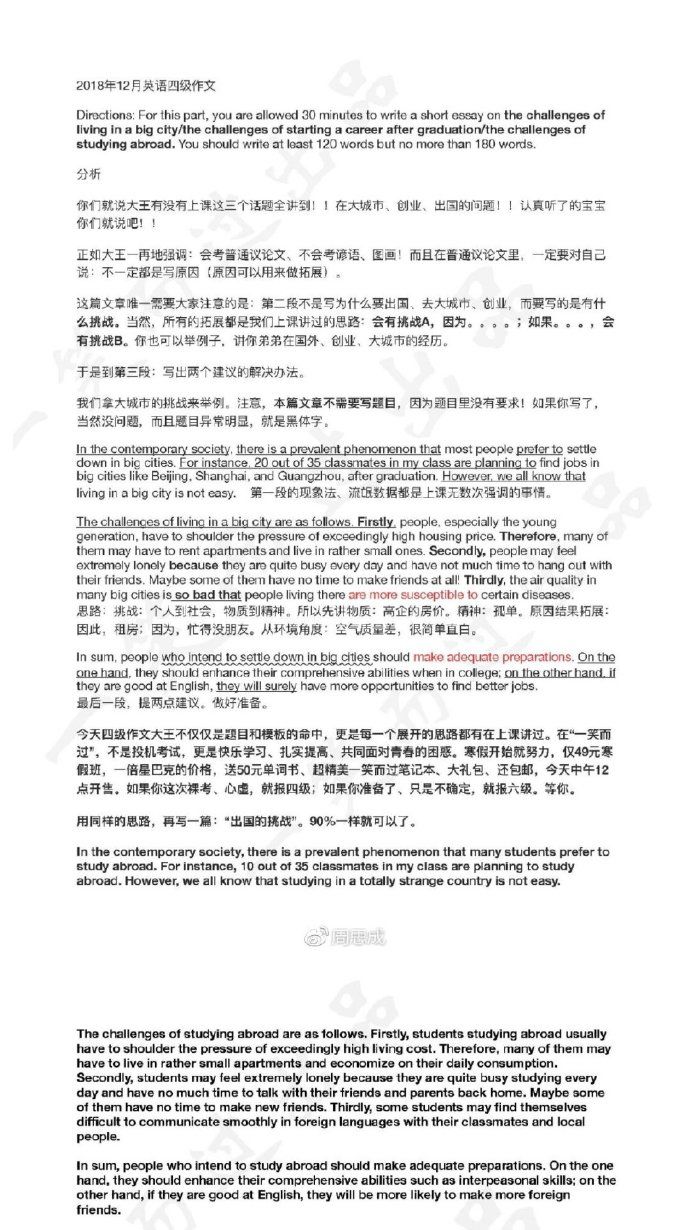LSAT模拟试题:LSAT模拟试题TEST2阅读1c
|
Three basic adaptive responses-regulatory, acclimatory, and developmental-may occur in organisms as they react to changing environmental conditions. In all three, adjustment of biological features (morphological adjustment) or of their use (functional adjustment) may occur. Regulatory responses involve rapid changes in the organism s use of its physiological apparatus-increasing or decreasing the rates of various processes, for example. Acclimation involves morphological change-thickening of fur or red blood cell proliferation-which alters physiology itself. Such structural changes require more time than regulatory response changes. Regulatory and acclimatory responses are both reversible. Developmental responses, however, are usually permanent and irreversible: they become fixed in the course of the individual's development in response to environmental conditions at the time the response occurs. One such response occurs in many kinds of water bugs. Most water-bug species inhabiting small lakes and ponds have two generations per year. The first hatches during the spring, reproduces during the summer, then dies. The eggs laid in the summer hatch and develop into adults in late summer. They live over the winter before breeding in early spring,. Individuals in the second (overwintering) generation have fully developed wings and leave the water in autumn to overwinter in forests, returning in spring to small bodies of water to lay eggs. Their wings are absolutely necessary for this seasonal dispersal. The summer (early) generation, in contrast, is usually dimorphic-some individuals have normal functional (macropterous) wings; others have much-reduced (micropterous) wings of no use for flight. The summer generation's dimorphism is a compromise strategy, for these individuals usually do not leave the ponds and thus generally have no use for fully developed wings. But small ponds occasionally dry up during the summer, forcing the water bugs to search for new habitats, an eventuality that macropterous individuals are well adapted to meet. The dimorphism of micropterous and macropterous individuals in the summer generation expresses developmental flexibility; it is not genetically determined. The individual's wing form is environmentally determined by the temperature to which developing eggs are exposed prior to their being laid. Eggs maintained in a warm environment always produce bugs with normal wing, but exposure to cold produces micropterous individuals. Eggs producing the overwintering brood are all formed during the late summer's warm temperatures. Hence, all individuals in the overwintering brood have normal wings. Eggs laid by the overwintering adults in the spring, which develop into the summer generation of adults, are formed in early autumn and early spring. Those eggs formed in autumn are exposed to cold winter temperatures, and thus produce micropterous adults in the summer generation. Those formed during the spring are never exposed to cold temperatures, and thus yield individuals with normal wing. Adult water bugs of the overwintering generation brought into the laboratory during the cold months and kept warm, produce only macropterous offspring. 14. The primary purpose of the passage is to (A) illustrate an organism's functional adaptive response to changing environmental conditions (B) prove that organisms can exhibit three basic adaptive responses to changing environmental conditions (C) explain the differences in form and function between micropterous and macropterous water bugs and analyze the effect of environmental changes on each (D) discuss three different types of adaptive responses and provide an example that explains how one of those types of responses works (E) contrast acclimatory responses with developmental responses and suggest an explanation for the evolutionary purposes of these two responses to changing environmental conditions 15. The passage supplies information to suggest that which one of the following would happen if a pond inhabited by water bugs were to dry up in June? (A) The number of developmental responses among the water-bug population would decrease. (B) Both micropterous and macropterous water bugs would show and acclimatory response. (C) The generation of water bugs to be hatched during the subsequent spring would contain an unusually large number of macropterous individuals. (D) The dimorphism of the summer generation would enable some individuals to survive. (E) The dimorphism of the summer generation would be genetically transferred to the next spring generation. 16. It can be inferred from the passage that if the winter months of a particular year were unusually warm, the (A) eggs formed by water bugs in the autumn would probably produce a higher than usual proportion of macropterous individuals (B) eggs formed by water bugs in the autumn would probably produce an entire summer generation of water bugs with smaller than normal wings (C) eggs of the overwintering generation formed in the autumn would not be affected by this temperature change (D) overwintering generation would not leave the ponds for the forest during the winter (E) overwintering generation of water bugs would most likely form fewer eggs in the autumn and more in the spring 17. According to the passage, the dimorphic wing structure of the summer generation of water bugs occurs because (A) the overwintering generation forms two sets of eggs, one exposed to the colder temperatures of winter and one exposed only to the warmer temperatures of spring (B) the eggs that produce micropterous and macropterous adults are morphologically different (C) water bugs respond to seasonal changes by making an acclimatory functional adjustment in the wings (D) water bugs hatching in the spring live out their life spans in ponds and never need to fly (E) the overwintering generation, which produces eggs developing into the dimorphic generation, spends the winter in the forest and the spring in small ponds 18. It can be inferred from the passage that which one of the following is an example of a regulatory response? (A) thickening of the plumage of some birds in the autumn (B) increase in pulse ate during vigorous exercise (C) gradual darkening of the skin after exposure to sunlight (D) gradual enlargement of muscles as a result of weight lifting (E) development of a heavy fat layer in bears before hibernation 19. According to the passage, the generation of water bugs hatching during the summer is likely to (A) be made up of equal numbers of macropterous and micropterous individuals (B) lay its eggs during the winter in order to expose them to cold (C) show a marked inability to fly from one pond to another (D) exhibit genetically determined differences in wing form from the early spring-hatched generation (E) contain a much greater proportion of macropterous water bugs than the early spring-hatched generation 20. The author mentions laboratory experiments with adult water bugs (lines 63-66) in order to illustrate which one of the following? (A) the function of the summer generation's dimorphism (B) the irreversibility of most developmental adaptive responses in water bugs (C) the effect of temperature on developing water-bug eggs (D) the morphological difference between the summer generation and the overwintering generation of water bugs (E) the functional adjustment of water bugs in response to seasonal temperature variation 21. Which one of the following best describes the organization of the passage? (A) Biological phenomena are presented, examples of their occurrence are compared and contrasted, and one particular example is illustrated in detail. (B) A description of related biological phenomena is stated, and two of those phenomena are explained in detail with illustrated examples. (C) Three related biological phenomena are described, a hypothesis explaining their relationship is presented, and supporting evidence is produce. (D) Three complementary biological phenomena are explained, their causes are examined, and one of them is described by contrasting its causes with the other tow. (E) A new way of describing biological phenomena is suggested, its applications are presented, and one specific example is examined in detail. |








